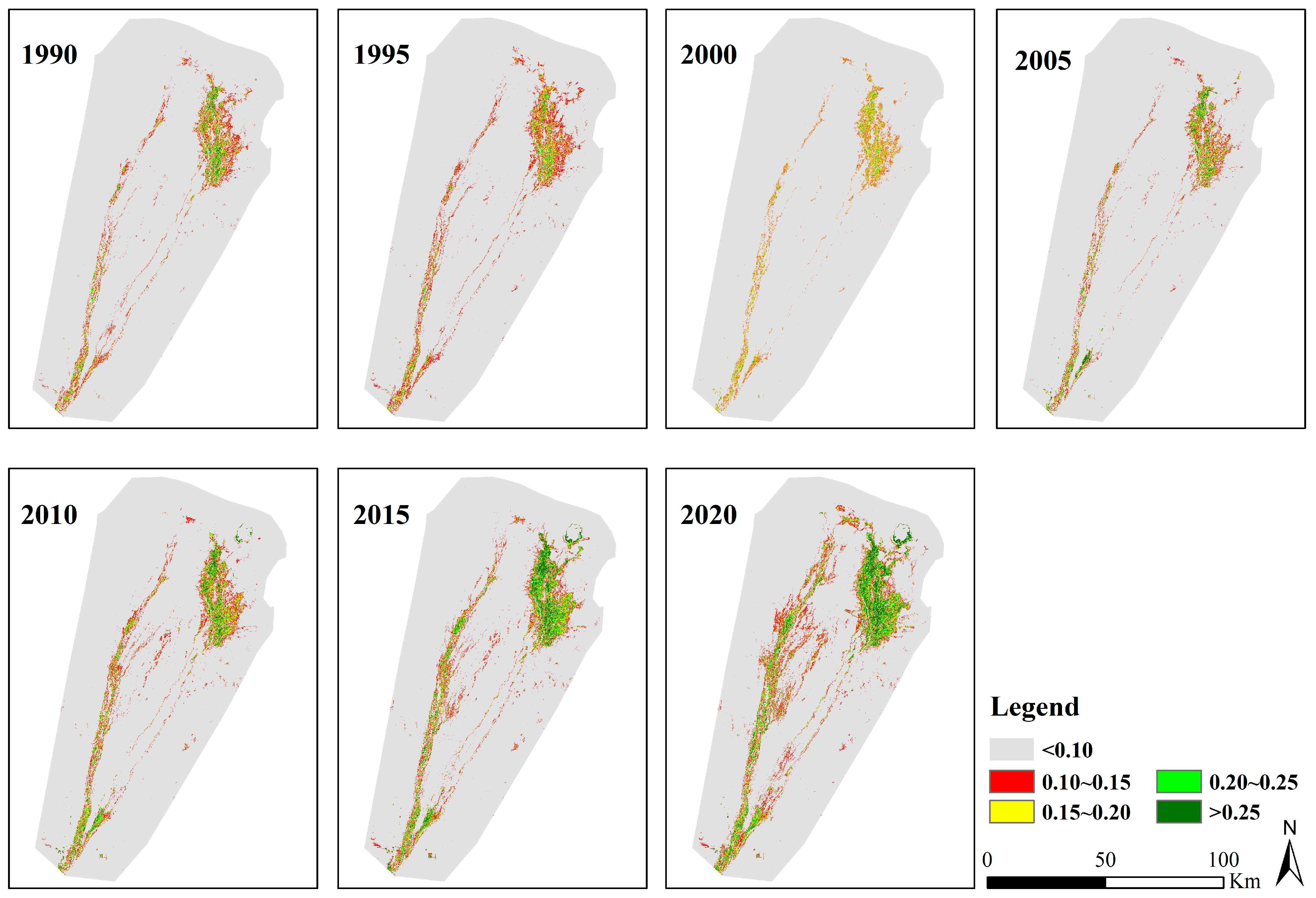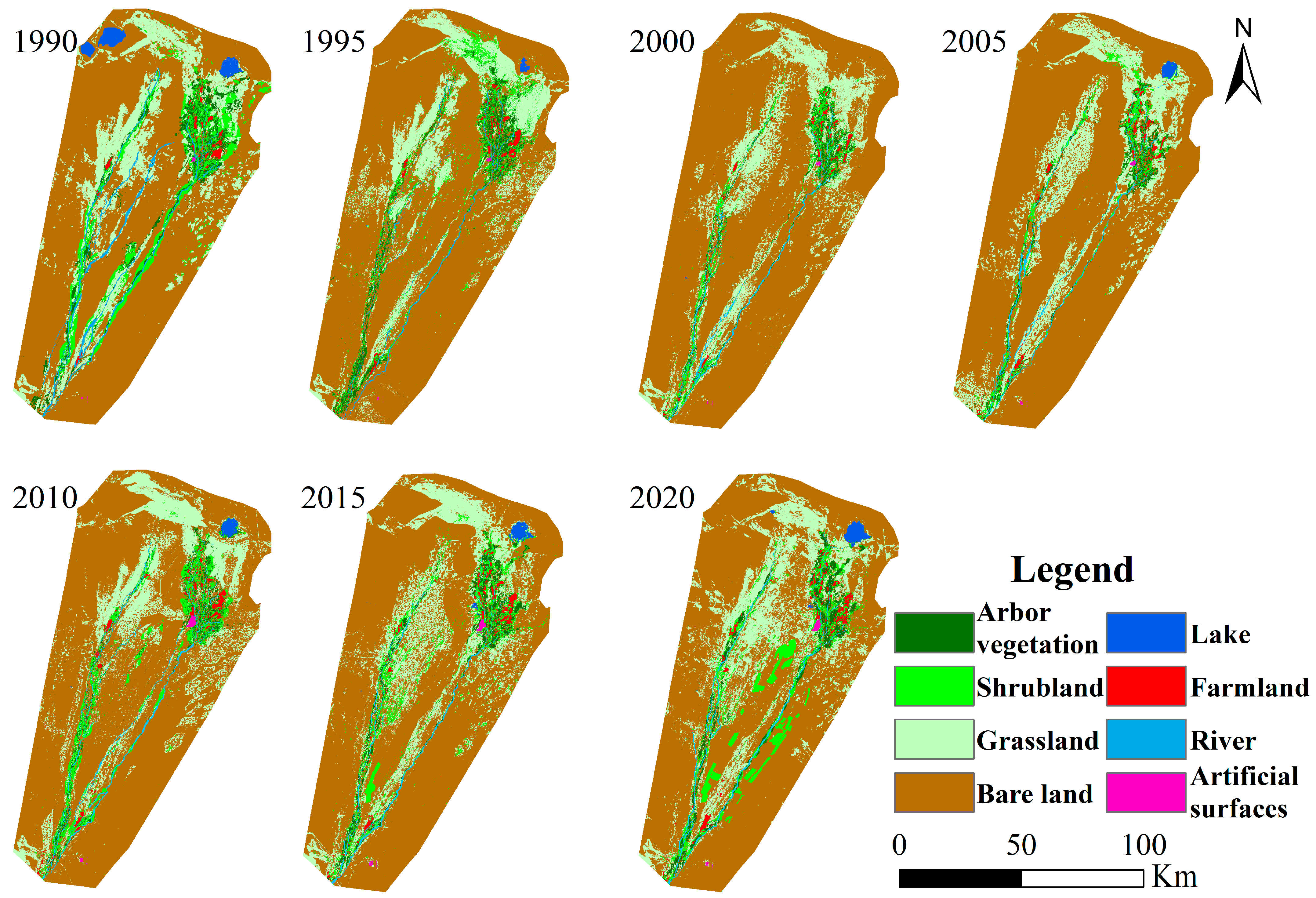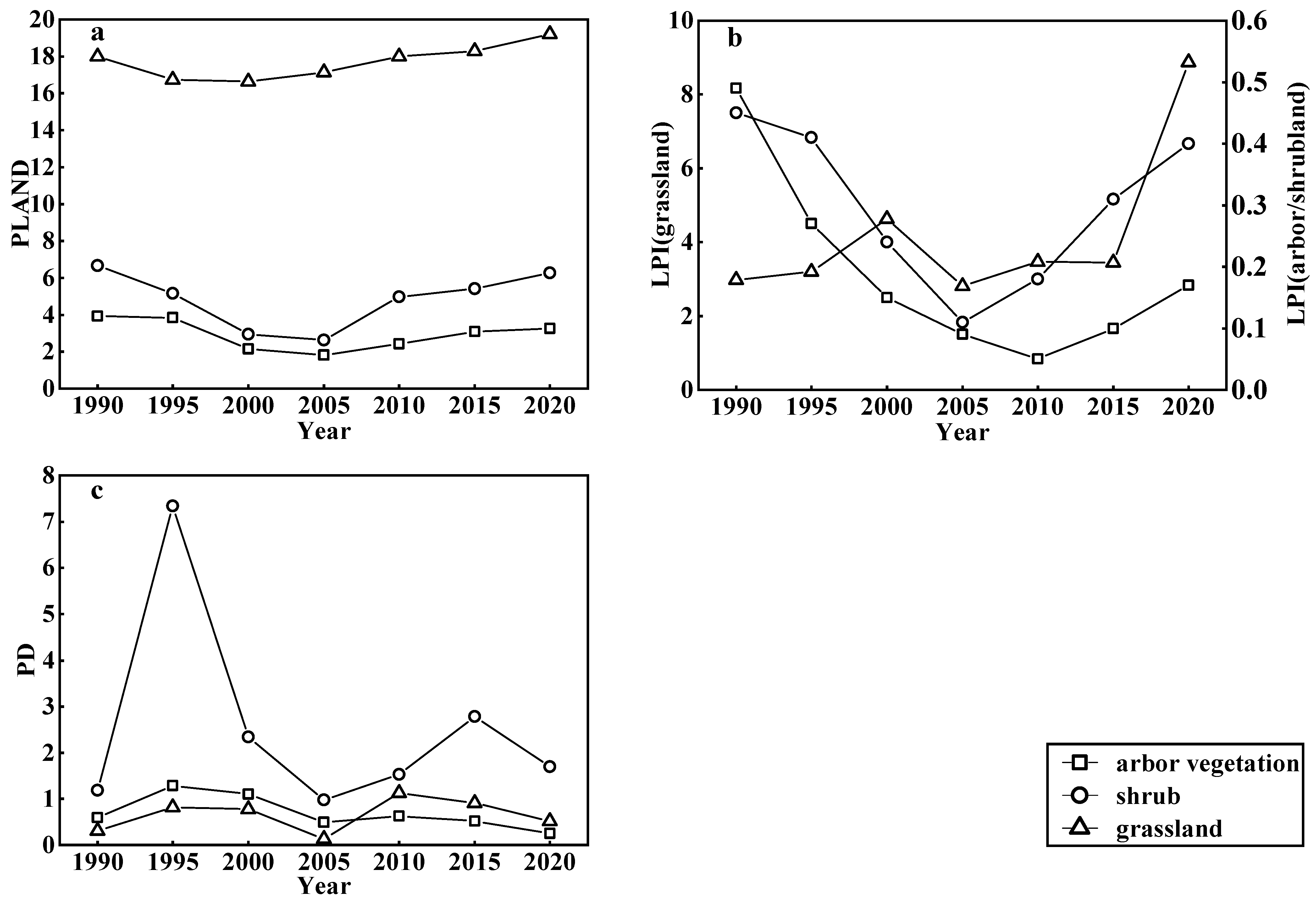Evolution of Vegetation Landscape Pattern Dynamics in Ejina Delta, Northwest China—Before and After Ecological Water Diversion
Abstract
1. Introduction
2. Study Area
3. Data and Methods
3.1. Data
3.2. Method
3.2.1. Landscape Type Changes
3.2.2. Landscape Metrics Analysis
4. Results
4.1. Spatiotemporal Variations in NDVI
4.2. Spatiotemporal Dynamics of Landscape Patterns
4.2.1. Landscape Dynamics Analysis
4.2.2. Landscape Pattern Analysis
5. Discussion
6. Conclusions
Author Contributions
Funding
Data Availability Statement
Acknowledgments
Conflicts of Interest
References
- Van Der Zee, S.E.A.T.M.; Stofberg, S.F.; Yang, X.; Liu, Y.; Islam, M.N.; Hu, Y.F. Irrigation and Drainage in Agriculture: A Salinity and Environmental Perspective. In Current Perspective on Irrigation and Drainage; Kulshreshtha, S., Elshorbagy, A., Eds.; InTech: Milton, Australia, 2017; ISBN 978-953-51-2951-6. [Google Scholar]
- Jobbágy, E.G.; Nosetto, M.D.; Villagra, P.E.; Jackson, R.B. Water Subsidies from Mountains to Deserts: Their Role in Sustaining Groundwater-Fed Oases in a Sandy Landscape. Ecol. Appl. 2011, 21, 678–694. [Google Scholar] [CrossRef] [PubMed]
- Jiao, W.; Wang, L.; Smith, W.K.; Chang, Q.; Wang, H.; D’Odorico, P. Observed Increasing Water Constraint on Vegetation Growth over the Last Three Decades. Nat.Commun. 2021, 12, 3777. [Google Scholar] [CrossRef] [PubMed]
- Lee, J.; Yin, X.; Zhu, H.; Zheng, X. Geographical Detector-Based Research of Spatiotemporal Evolution and Driving Factors of Oasification and Desertification in Manas River Basin, China. Land 2023, 12, 1487. [Google Scholar] [CrossRef]
- Marasco, R.; Fusi, M.; Ramond, J.B.; Van Goethem, M.W.; Seferji, K.; Maggs-Kölling, G.; Cowan, D.A.; Daffonchio, D. The Plant Rhizosheath–Root Niche Is an Edaphic “Mini-Oasis” in Hyperarid Deserts with Enhanced Microbial Competition. ISME Commun. 2022, 2, 47. [Google Scholar] [CrossRef]
- Song, W.; Zhang, Y. Expansion of Agricultural Oasis in the Heihe River Basin of China: Patterns, Reasons and Policy Implications. Phys. Chem. Earth 2015, 89–90, 46–55. [Google Scholar] [CrossRef]
- Ngondo, J.; Mango, J.; Liu, R.; Nobert, J.; Dubi, A.; Cheng, H. Land-Use and Land-Cover (LULC) Change Detection and the Implications for Coastal Water Resource Management in the Wami–Ruvu Basin, Tanzania. Sustainability 2021, 13, 4092. [Google Scholar] [CrossRef]
- Zeng, J.; Cui, Y. Vegetation–Topographic Landscape and the Influence of Water and Sediment in the Shule River Basin. Atmosphere 2024, 15, 459. [Google Scholar] [CrossRef]
- Zhang, C.; Li, Y. Verification of Watershed Vegetation Restoration Policies, Arid China. Sci. Rep. 2016, 6, 30740. [Google Scholar] [CrossRef]
- Zhu, C.; Shen, Q.; Zhang, K.; Zhang, X.; Li, J. Multiscale Detection and Assessment of Vegetation Eco-Environmental Restoration Following Ecological Water Compensation in the Lower Reaches of the Tarim River, China. Remote Sens. 2022, 14, 5855. [Google Scholar] [CrossRef]
- Ke, H.; Tian, M.; Liang, L.; Yuan, C.; Wang, M.; Gao, Y. Analysis of Ecological Environment Changes Associate with Driving Factors in the Inland River Basin of Northwest China Based on GeoDetector. Pol. J. Environ. Stud. 2025, 34, 719–733. [Google Scholar] [CrossRef]
- Lu, J.; Li, L.; Jiang, E.; Gan, R.; Liu, C.; Deng, Y. Ecological Water Demand Estimations for Desert Terminal Lake Survival under Inland River Water Diversion Regulation. Water 2022, 15, 66. [Google Scholar] [CrossRef]
- Vasilevskiy, P.; Wang, P.; Pozdniakov, S.; Wang, T.; Zhang, Y.; Zhang, X.; Yu, J. Simulating River/Lake–Groundwater Exchanges in Arid River Basins: An Improvement Constrained by Lake Surface Area Dynamics and Evapotranspiration. Remote Sens. 2022, 14, 1657. [Google Scholar] [CrossRef]
- Gong, J.D.; Cheng, G.D.; Zhang, X.Y.; Xiao, H.L.; Li, X.Y. Environmental evolution in the Ejina region of the lower reaches of the Heihe River. Adv. Earth Sci. 2002, 17, 491–496. (In Chinese) [Google Scholar]
- Huang, F.; Wang, W.B.; Dong, G.T. Ecological priority and green development: Making the Heihe River a river of well-being. In Proceedings of the Symposium on Building Happy Rivers and Lakes in Response to New Era Water Reform; Heihe River Basin Authority, Yellow River Conservancy Commission: Heihe, China, 2021; pp. 141–144. (In Chinese). [Google Scholar]
- Hu, X.; Lu, L.; Li, X.; Wang, J.; Lu, X. Ejin Oasis Land Use and Vegetation Change between 2000 and 2011: The Role of the Ecological Water Diversion Project. Energies 2015, 8, 7040–7057. [Google Scholar] [CrossRef]
- Wang, C.; Zhang, Y.Y.; Zhao, W.Z. Eco-hydrological restoration effect of ecological water conveyance in Ejina oasis, lower reaches of the Heihe River in recent 20 years. Chin. J. Ecol. 2022, 41, 2180–2187. (In Chinese) [Google Scholar]
- Zhang, Y.C.; Yu, J.J.; Wang, P.; Fu, G.B. Vegetation Responses to Integrated Water Management in the Ejina Basin, Northwest China. Hydrol. Process. 2011, 25, 3448–3461. [Google Scholar] [CrossRef]
- Zhang, J.; Wang, P.; Liu, S.; Yu, J. Mechanism Controlling Groundwater Chemistry in the Hyper-Arid Basin with Intermittent River Flow: Insights from Long-Term Observations (2001–2023) in the Lower Heihe River, Northwest China. Front. Environ. Sci. 2024, 12, 1376443. [Google Scholar] [CrossRef]
- Li, Y.F.; Yu, J.J.; Lu, K.; Wang, P.; Zhang, Y.C.; Du, C.Y. Water sources of Populus euphratica and Tamarix ramosissima in Ejina Delta, the lower reaches of the Heihe River, China. Chin. J. Plant Ecol. 2017, 41, 519–528. (In Chinese) [Google Scholar]
- Jiao, A.; Wang, W.; Ling, H.; Deng, X.; Yan, J.; Chen, F. Effect Evaluation of Ecological Water Conveyance in Tarim River Basin, China. Front. Environ. Sci. 2022, 10, 1019695. [Google Scholar] [CrossRef]
- Chen, Y.; Chen, Y.; Zhu, C.; Wang, Y.; Hao, X. Ecohydrological Effects of Water Conveyance in a Disconnected River in an Arid Inland River Basin. Sci. Rep. 2022, 12, 9982. [Google Scholar] [CrossRef]
- Bao, H.M.; Wang, J.M.; Zhao, H.J.; Amugulang. Landscape Pattern Dynamic Changes in the Core Area of Ejina Oasis after Heihe Water Allocation. For. Inventory Plann. 2015, 40, 36–41. (In Chinese) [Google Scholar]
- Zhang, G.; Su, X.; Singh, V.P.; Ayantobo, O.O. Modeling NDVI Using Joint Entropy Method Considering Hydro-Meteorological Driving Factors in the Middle Reaches of Hei River Basin. Entropy 2017, 19, 502. [Google Scholar] [CrossRef]
- Triplett, A.; Condon, L.E. Climate-Warming-Driven Changes in the Cryosphere and Their Impact on Groundwater–Surface-Water Interactions in the Heihe River Basin. Hydrol. Earth Syst. Sci. 2023, 27, 2763–2785. [Google Scholar] [CrossRef]
- Lv, Z.; Li, S.; Xu, X.; Lei, J.; Peng, Z. Ecological Risk Assessment of Landscape in Arid Area Watersheds under Ecological Water Conveyance: A Case Study of Taitema Lake. Heliyon 2024, 10, e29575. [Google Scholar] [CrossRef]
- Zhang, P.; Deng, X.; Long, A.; Xu, H.; Ye, M.; Li, J. Change in Spatial Distribution Patterns and Regeneration of Populus Euphratica under Different Surface Soil Salinity Conditions. Sci. Rep. 2019, 9, 9123. [Google Scholar] [CrossRef]
- Liu, B.; Song, W. Mapping Abandoned Cropland Using Within-Year Sentinel-2 Time Series. Catena 2023, 223, 106924. [Google Scholar] [CrossRef]
- Zuo, L.J.; Xu, J.Y. Spatial-Temporal Land Use Change and Landscape Response in Bohai Sea Coastal Zone Area. Natl. Remote Sens. Bull. 2011, 15, 604–620. [Google Scholar]
- Yan, R.; Wang, S.; Du, Y. Development of a Two-Stage Ship Fuel Consumption Prediction and Reduction Model for a Dry Bulk Ship. Transp. Res. E Logist. Transp. Rev. 2020, 138, 101930. [Google Scholar] [CrossRef]
- Chen, D.; Zheng, J.; Wei, G.-W.; Pan, F. Extracting Predictive Representations from Hundreds of Millions of Molecules. J. Phys. Chem. Lett. 2021, 12, 10793–10801. [Google Scholar] [CrossRef]
- Liu, Y.; Wang, Y.; Lin, Y.; Ma, X.; Guo, S.; Ouyang, Q.; Sun, C. Habitat Quality Assessment and Driving Factors Analysis of Guangdong Province, China. Sustainability 2023, 15, 11615. [Google Scholar] [CrossRef]
- Zhang, Y.; Su, T.; Ma, Y.; Wang, Y.; Wang, W.; Zha, N.; Shao, M. Forest Ecosystem Service Functions and Their Associations with Landscape Patterns in Renqiu City. PLoS ONE 2022, 17, e0265015. [Google Scholar] [CrossRef] [PubMed]
- Niu, H.; Zhao, X.; Xiao, D.; Liu, M.; An, R.; Fan, L. Evolution and Influencing Factors of Landscape Pattern in the Yellow River Basin (Henan Section) Due to Land Use Changes. Water 2022, 14, 3872. [Google Scholar] [CrossRef]
- Zhang, L.Y.; Xia, J.S.; Ye, W.H. Discussion on Selection of Landscape Pattern Analysis Indices. Yunnan Geogr. Environ. Res. 2008, 20, 38–43. (In Chinese) [Google Scholar]
- Sertel, E.; Topaloğlu, R.; Şallı, B.; Yay Algan, I.; Aksu, G. Comparison of Landscape Metrics for Three Different Level Land Cover/Land Use Maps. IJGI 2018, 7, 408. [Google Scholar] [CrossRef]
- Luo, Y.; Wang, Z.; Zhou, X.; Hu, C.; Li, J. Spatial-Temporal Driving Factors of Urban Landscape Changes in the Karst Mountainous Regions of Southwest China: A Case Study in Central Urban Area of Guiyang City. Sustainability 2022, 14, 8274. [Google Scholar] [CrossRef]
- Cao, Y.; Li, Y.; Li, X.; Wang, X.; Dai, Z.; Duan, M.; Xu, R.; Zhao, S.; Liu, X.; Li, J.; et al. Relationships between the Visual Quality and Color Patterns: Study in Peri-Urban Forests Dominated by Cotinus Coggygria Var. Cinerea Engl. in Autumn in Beijing, China. Forests 2022, 13, 1996. [Google Scholar] [CrossRef]
- Li, F.; Zheng, W.; Wang, Y.; Liang, J.; Xie, S.; Guo, S.; Li, X.; Yu, C. Urban Green Space Fragmentation and Urbanization: A Spatiotemporal Perspective. Forests 2019, 10, 333. [Google Scholar] [CrossRef]
- Xu, G.; Ren, X.; Yang, Z.; Long, H.; Xiao, J. Influence of Landscape Structures on Water Quality at Multiple Temporal and Spatial Scales: A Case Study of Wujiang River Watershed in Guizhou. Water 2019, 11, 159. [Google Scholar] [CrossRef]
- Jin, X.M.; Schaepman, M.; Clevers, J.; Su, Z.; Hu, G. Correlation Between Annual Runoff in the Heihe River to the Vegetation Cover in the Ejina Oasis (China). Arid Land Res. Manag. 2010, 24, 31–41. [Google Scholar] [CrossRef]
- Gao, G.L.; Zhang, X.Y.; Yu, T.F. Land cover change and its driving forces in the Ejin Oasis during 1987–2008. J. Desert Res. 2015, 35, 821–828. (In Chinese) [Google Scholar]
- Zhang, H.; Xue, L.; Wei, G.; Dong, Z.; Meng, X. Assessing Vegetation Dynamics and Landscape Ecological Risk on the Mainstream of Tarim River, China. Water 2020, 12, 2156. [Google Scholar] [CrossRef]
- Song, D.; Pei, X.; Mao, L.; Wang, J.; Tian, Y.; An, X.; An, H. Study on the Spatial–Temporal Variation of Groundwater Depth and Its Impact on Vegetation Coverage in Ejina Oasis. Forests 2024, 15, 2034. [Google Scholar] [CrossRef]
- Wang, P.; Yu, J.; Zhang, Y.; Fu, G.; Min, L.; Ao, F. Impacts of Environmental Flow Controls on the Water Table and Groundwater Chemistry in the Ejina Delta, Northwestern China. Environ. Earth Sci. 2011, 64, 15–24. [Google Scholar] [CrossRef]
- Zhang, Z.Y.; Zhao, P.; Chang, X.S.; Wang, Y.Z.; Dong, G.T. Analysis of Groundwater Depth Change in Ejina Oasis from 1992 to 2015. Yellow River 2019, 41, 33–37. (In Chinese) [Google Scholar]
- Troch, P.A.; Dwivedi, R.; Liu, T.; Meira Neto, A.A.; Roy, T.; Valdés-Pineda, R.; Durcik, M.; Arciniega-Esparza, S.; Breña-Naranjo, J.A. Catchment-Scale Groundwater Recharge and Vegetation Water Use Efficiency. Hydrol. Earth Syst. Sci. 2018, 1–46. [Google Scholar] [CrossRef]
- Acharya, B.S.; Kharel, G.; Zou, C.B.; Wilcox, B.P.; Halihan, T. Woody Plant Encroachment Impacts on Groundwater Recharge: A Review. Water 2018, 10, 1466. [Google Scholar] [CrossRef]
- Peng, L.; Wan, Y.; Shi, H.; Anwaier, A.; Shi, Q. Influence of Climate, Topography, and Hydrology on Vegetation Distribution Patterns—Oasis in the Taklamakan Desert Hinterland. Remote Sens. 2023, 15, 5299. [Google Scholar] [CrossRef]
- Nian, Y.Y.; Wang, X.L.; Cai, D.H. Analysis on Climate and Ecological Environment Change in the Ejin Delta, the Lower reaches of the Heihe River. J. Arid. Meteorol. 2015, 33, 28–37. (In Chinese) [Google Scholar]
- Wang, P.; Yu, J.; Zhang, Y.; Liu, C. Groundwater Recharge and Hydrogeochemical Evolution in the Ejina Basin, Northwest China. J. Hydrol. 2013, 476, 72–86. [Google Scholar] [CrossRef]
- Xu, R.Z.; Wei, S.B.; Li, C.Y.; Cheng, X.X.; Zhou, X.Y. Groundwater circulation in the Ejina Plain: Insights from hydrochemical and environmental isotope studies. Earth Sci. Front. 2023, 30, 440–450. (In Chinese) [Google Scholar]








| Landscape Metric | Level | Formulation | Interpretations |
|---|---|---|---|
| PLAND | Class Level | indicates the total area of a certain type of patch; A indicates the total area of landscape. | The proportion of the area of a certain type of landscape (0–100). The larger the value, the larger the area of this type [36]. |
| PD | Class Level | represents the number of patches in the type i of landscape; A indicates the total area of landscape. | The number patches per unit area. The larger the value, the higher the degree of fragmentation [37]. |
| LPI | Class Level | indicates the area of the largest patch in a certain type of landscape; A indicates the total area of landscape. | The proportion of the largest patch in a patch type to the entire landscape area. The larger of the value, the larger the area of patch contiguity [37]. |
| NP | Landscape Level | indicates number of patches representing type i. | The heterogeneity of the landscape. The greater the number of patches, the more fragmented the landscape [38]. |
| LSI | Landscape Level | : m indicates the number of patch types; indicates the total length of adjacent patches between type i and type k. | The complex shape of the landscape. The larger the value, the more irregular the shape, the higher the landscape complexity, and the lower the stability [39]. |
| PAFRAC | Landscape Level | indicates the area of patch ij; Pij indicates the circumference of patch ij; indicates the number of patches. | The degree of complexity of the landscape type. The larger the value, the more complex the shape of the landscape, and the more natural the landscape [40]. |
| SHDI | Landscape Level | indicates the probability of patch type i appearing in the landscape; m indicates types of patches in the landscape. | The richness of landscape components and the dynamic changes in the proportion of distinct landscape classes (>0). The larger the value, the more diverse the landscape types, and the higher the degree of heterogeneity [40]. |
| Year | Bare Land (<0.10) | Low Coverage (0.10–0.15) | Moderate Coverage (0.15–0.20) | High Coverage (0.20–0.25) | Higher Coverage (>0.25) |
|---|---|---|---|---|---|
| 1990 | 94.42% | 3.08% | 1.55% | 0.69% | 0.26% |
| 1995 | 93.96% | 3.80% | 1.60% | 0.54% | 0.10% |
| 2000 | 96.10% | 2.47% | 1.07% | 0.31% | 0.05% |
| 2005 | 95.21% | 2.46% | 1.32% | 0.65% | 0.36% |
| 2010 | 92.54% | 3.55% | 2.13% | 1.10% | 0.68% |
| 2015 | 90.55% | 3.80% | 2.45% | 1.65% | 1.55% |
| 2020 | 87.18% | 5.29% | 3.25% | 2.16% | 2.12% |
Disclaimer/Publisher’s Note: The statements, opinions and data contained in all publications are solely those of the individual author(s) and contributor(s) and not of MDPI and/or the editor(s). MDPI and/or the editor(s) disclaim responsibility for any injury to people or property resulting from any ideas, methods, instructions or products referred to in the content. |
© 2025 by the authors. Licensee MDPI, Basel, Switzerland. This article is an open access article distributed under the terms and conditions of the Creative Commons Attribution (CC BY) license (https://creativecommons.org/licenses/by/4.0/).
Share and Cite
Dong, J.; Du, C.; Yu, J. Evolution of Vegetation Landscape Pattern Dynamics in Ejina Delta, Northwest China—Before and After Ecological Water Diversion. Remote Sens. 2025, 17, 1843. https://doi.org/10.3390/rs17111843
Dong J, Du C, Yu J. Evolution of Vegetation Landscape Pattern Dynamics in Ejina Delta, Northwest China—Before and After Ecological Water Diversion. Remote Sensing. 2025; 17(11):1843. https://doi.org/10.3390/rs17111843
Chicago/Turabian StyleDong, Jingru, Chaoyang Du, and Jingjie Yu. 2025. "Evolution of Vegetation Landscape Pattern Dynamics in Ejina Delta, Northwest China—Before and After Ecological Water Diversion" Remote Sensing 17, no. 11: 1843. https://doi.org/10.3390/rs17111843
APA StyleDong, J., Du, C., & Yu, J. (2025). Evolution of Vegetation Landscape Pattern Dynamics in Ejina Delta, Northwest China—Before and After Ecological Water Diversion. Remote Sensing, 17(11), 1843. https://doi.org/10.3390/rs17111843






